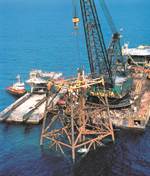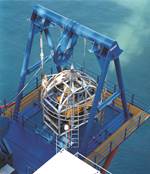Template Towers
The concept of steel templates was one of the first to emerge for small platforms. The idea was to built a braced-leg jacket (i.e., a tower structure that surrounds the well and riser) on shore, then ship it to the site and install it offshore. These strong and stable platforms are still used today. The accept
Share
Read Next
The concept of steel templates was one of the first to emerge for small platforms. The idea was to built a braced-leg jacket (i.e., a tower structure that surrounds the well and riser) on shore, then ship it to the site and install it offshore. These strong and stable platforms are still used today. The acceptance of this design led to its standardization by many operators. By building a number of what Humble Oil called “template towers” (10 ft/3m square) components, platforms of varying sizes could be assembled to support drilling exploration, offshore crew quarters and, if a discovery were made, production activities. The only drawback was a high price tag. Because of this, and the uncertainty of early exploration drilling, many of the ensuing platforms would combine smaller template towers with tender vessels.
Because of the expense attached to drilling a dry hole, what was needed was a truly mobile offshore rig. The first of these was the submersible drilling barge developed in the 1940s. The submersible barge carried elevated decks mounted on steel piles. The barge was pumped full of water and would sink. As the hull rested on the bottom, the deck remained above water. When drilling was complete the water was pumped out of the barge and it could then be towed to another drilling location. For deeper waters such as those off the shore of California, the floating drillship was developed. These ship-shaped vessels could carry huge payloads, and could drill wells through a hole in the center of the vessel called the moon pool.
Because of the advent of such mobile drilling units, offshore exploration flourished in the early 1950s. The offshore arena, blessed with a 25 percent success rate compared to 10 percent for onshore drilling, was so successful, in fact, that in 1955 an oil glut occurred when oversupply led to a drop in prices. Many of the larger offshore prospects had by this time been identified and this led to an increase in the number of dry holes. This, coupled with the high cost of offshore drilling as well as interest in nuclear power, lead to a slowdown in offshore exploration and production.
Related Content
-
Plant tour: Middle River Aerostructure Systems, Baltimore, Md., U.S.
The historic Martin Aircraft factory is advancing digitized automation for more sustainable production of composite aerostructures.
-
Infinite Composites: Type V tanks for space, hydrogen, automotive and more
After a decade of proving its linerless, weight-saving composite tanks with NASA and more than 30 aerospace companies, this CryoSphere pioneer is scaling for growth in commercial space and sustainable transportation on Earth.
-
Composites manufacturing for general aviation aircraft
General aviation, certified and experimental, has increasingly embraced composites over the decades, a path further driven by leveraged innovation in materials and processes and the evolving AAM market.











